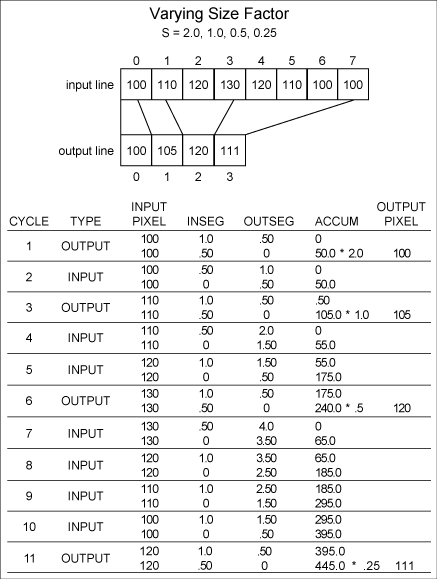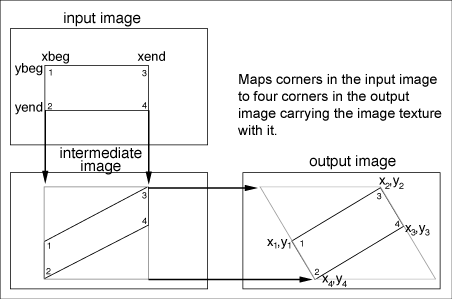Nonconstant-Size-Factor
Mapping
So
far only situations that perform an entire mapping
with a constant size factor have been discussed.
If the size factor, and hence INSFAC, are varied
for each new output pixel, any arbitrary mapping
of contiguous pixel values can be achieved.
Figure
10 is a one-dimensional example of a mapping
with a size factor that halves for each output
pixel.
Figure
10. Example with varying size factor.

Limited-Time
Performance
For
contiguous mappings of consecutive input pixels
into consecutive output pixels, a maximum time
limit can be established. The nature of the interpolation
algorithm is such that every cycle is either completing
an output pixel or using up an input pixel. This
includes zero cycles (see Figure
4). If there are 512 input pixels and a range
of 512 possible output pixels, and if pretransform
clipping is performed to ensure that only output
pixels that fall within the output line are generated
by the algorithm, then the algorithm will not
use up more than 512 input pixels nor generate
more than 512 output pixels. Any arbitrary contiguous
mapping can be guaranteed to occur in 1024 cycles.
A worst case, interestingly enough, is a size
factor of 1.0 where, for instance, 512 output
pixels are generated directly from the corresponding
input pixel and 512 zero cycles are generated
to get the next input pixel. A size factor of
slightly less than 1.0 uses 1024 cycles with no
zero cycles. This ability to deterministically
bound the computation, plus the simplicity of
the computation, makes the algorithm ideal for
real-time implementation.
A
Two-Dimensional Transform
Two-dimensional
images can be spatially transformed by combining
a series of one-dimensional interpolations in
two passes over the image. The first pass, which
we will consider to be the vertical pass, maps
all input pixels into their correct vertical orientation
and creates an intermediate image. The second,
or horizontal, pass maps all the pixels from the
intermediate image into their correct horizontal
orientation to create the final output image.
A technique of mapping to four target corner points
to achieve size, translation, and rotation of
an image can be used.
Four-Corner-to-Four-Corner
Mapping Procedure
This
procedure operates on an input image residing
in a bounded image plane and maps the input image
into a bounded output image plane. Line and column
extents XBEG, XEND, YBEG, and YEND specify the
bounds and the four corner points of the input
image to be mapped. Four target corner points
specify the corner points of the mapping in the
output image plane. These target corner points
can be computed by applying standard coordinate
transforms to the input corner points.
Both
input and output images use a fractional-valued
coordinate system overlaying the discrete grid
of pixels, as shown in Figure
11. All computations are in relation to this
reference system. The origin is at the upper-left
corner, X values increase to the right and Y values
increase downward.
Figure
12 illustrates the four-corner transform.
The input image corner points are labeled 1, 2,
3, 4, and the target corner points corresponding
to the input points are similarly labeled. The
figure shows the mapping from the input image
to the intermediate image and the intermediate
image to the output image.
The
first, or vertical, pass maps all intensities
into their correct vertical orientation column
by column. Corner I must be mapped to Y1, and
corner 4 must be mapped to Y4; therefore, the
correct vertical orientation for the first, or
leftmost, column of the input image is between
Y1 and Y4. The correct vertical orientation for
the last, or rightmost, column is between Y2 and
Y3. The correct vertical orientation for all intervening
columns is along uniformly interpolated positions
between the first and last column.
Figure
11. Real-valued coordinate system over image.

Figure
12. Four-corner-to-four-corner mapping technique.

The
real output location (ROTLOC) and size factor
(SIZFAC) for the first column are:
ROTLOC = Y1
SIZFAC = ( Y4-Y1)/( YEND-YBEG
+ I)
The
size factor for a rectangular output transform
is a constant for all columns, but the output
location varies. This variation is linear and
can be accommodated by adding an increment (LOCDLT)
to ROTLOC for each successive column. This increment
is:
LOCDLT = ( Y2- Y1)/(XEND-XBEG)
The
value of ROTLOC will be incremented by LOCDLT
for each successive column one less time than
the number of columns, and the output location
(ROTLOC) for the last column will equal Y2. For
nonrectangular output mappings, an increment can
be similarly applied to the size factor.
The
values to initialize the interpolation algorithm
for each column are:
SIZFAC = SIZFAC
INSFAC = I/SIZFAC
INSEG = 1.0
OUTSEG = INSFAC * (1.0
- fraction (ROTLOC) )
OUTLOC = Integer (ROTLOC)
INLOC = YBEG
If
ROTLOC is less than 0.0, clipping must be performed
by projecting the left edge of the zero output
pixel into the input line. The input line offset
(INOFF) is:
INOFF = -ROTLOC * INSFAC
The
values to initialize the interpolation algorithm
for clipped columns are:
SIZFAC = SIZFAC
INSFAC = 1.0 /SIZFAC
INSEG = 1.0 - fraction
(INOFF)
OUTSEG = INSFAC
OUTLOC = 1
INLOC = YBEG + Integer
(INOFF)
After
the interpolation process has operated on each
column of the input image, an intermediate image
is produced, as shown in Figure
12. The next step is to transform the intermediate
image row by row into the output image.
The
extents of the intermediate image are from XBEG
to XEND and from Integer (Y2) to Integer (Y4).
This bounding rectangle is the input to the second
pass. The triangular areas in the rectangle outside
the intermediate image must be set to zero.
The
second pass basically maps the 4-1 edge of the
inter- mediate image into the 4-1 edge projected
through Y2 of the output image with a size factor
such that the 2-3 edge of the intermediate image
maps to the 2-3 edge of the output image.
Beginning
at the top, the output location for the first
row is the intersection of the 1-4 edge with Y
= Y2.
ROTLOC = ((( Y2 - Y4)
* (X1 - X4)) / ( Y1 - Y4)) + X4
The
intermediate image line must be stretched a little
to fit between ROTLOC and X2. The size factor
is:
SIZFAC = (X2-ROTLOC) /
(XEND - XBEG + 1)
The
last ROTLOC must equal X4 after Integer ( Y4)
- Integer ( Y2) increments, so the location delta
is:
LOCDLT = (X4 - ROTLOC)
/ (Integer ( Y4) - Integer ( Y2))
The
values to initialize the interpolation process
for each row are:
SIZFAC = SIZFAC
INSFAC = 1/ SIZFAC
INSEG = 1.0
OUTSEG = INSFAC * (1.0
- fraction (ROTLOC) )
OUTLOC = Integer (ROTLOC)
INLOC = YBEG
These
are identical to the values for the first pass.
Clipping is also performed exactly as in the first
pass.
Mapping
of the first row, which consists mostly of zeros,
begins at the initial ROTLOC with the proper size
factor such that the data at corner 2 of the intermediate
image maps into corner 2 of the output image.
As for each successive row, ROTLOC moves along
the 4-1 edge of the output image the 2-3 edge
of the intermediate image is mapped to the 2-3
edge of the output image. The internal data of
the image follows with these edge mappings through
both passes and is itself correctly and proportionally
mapped. |